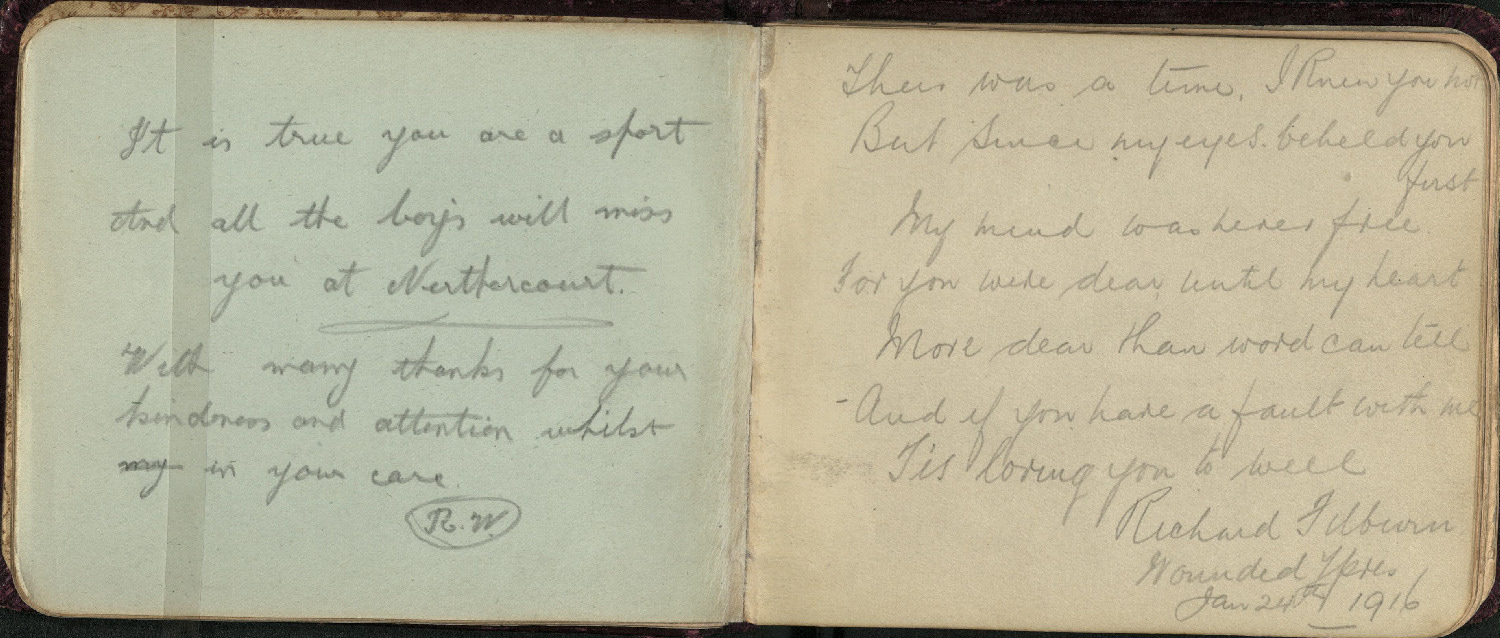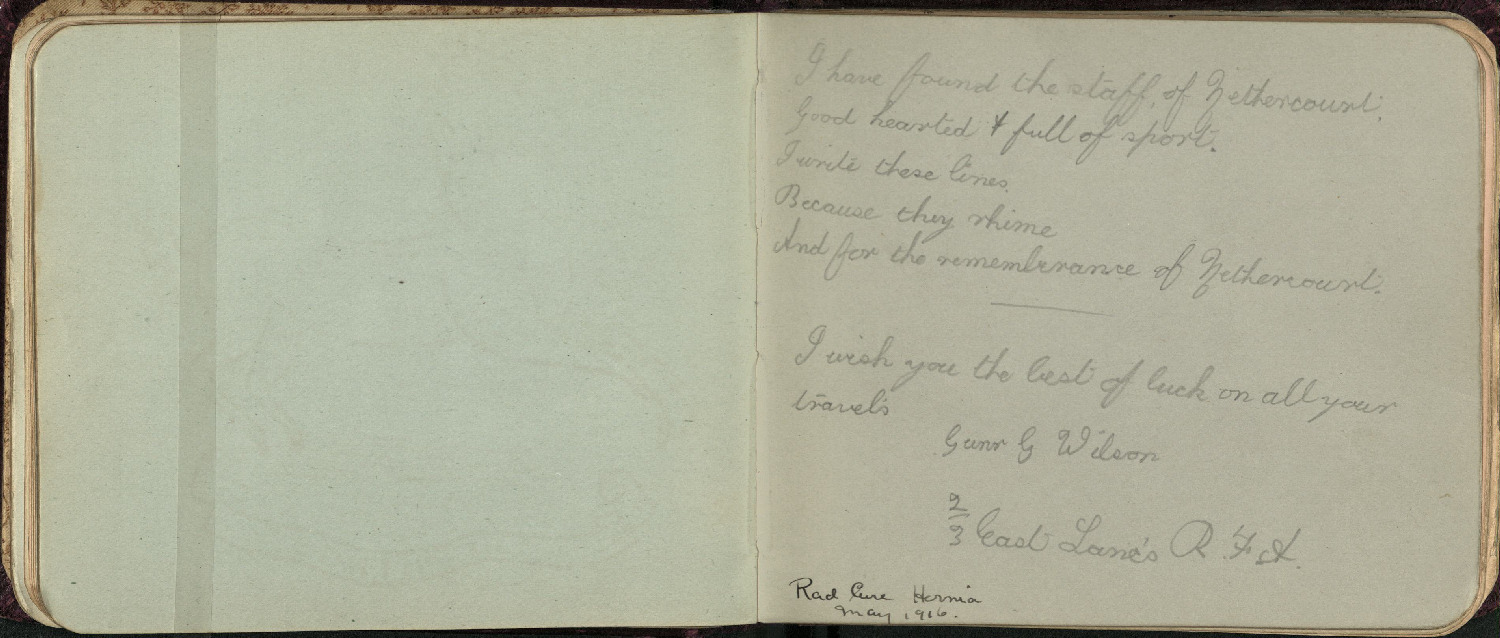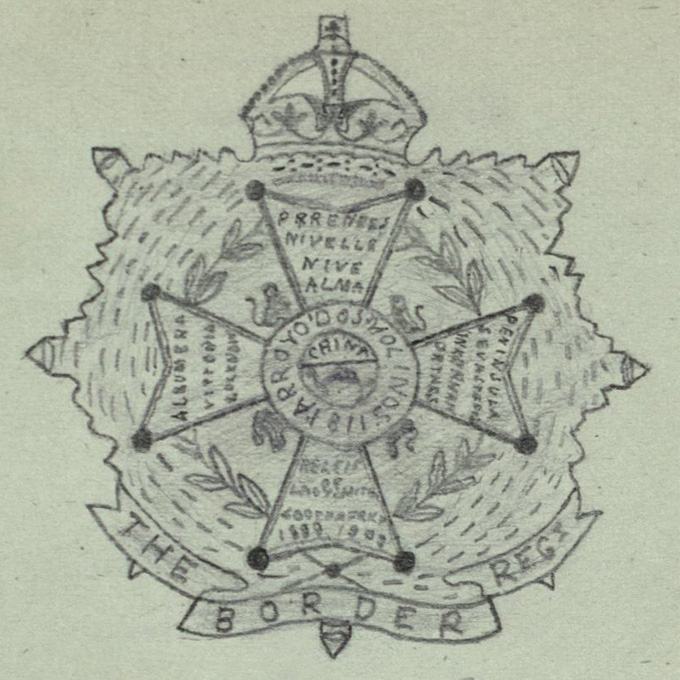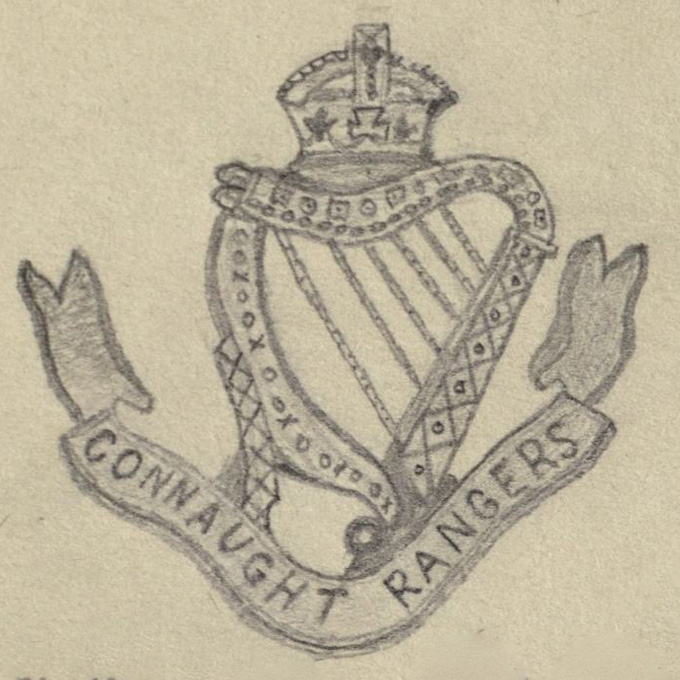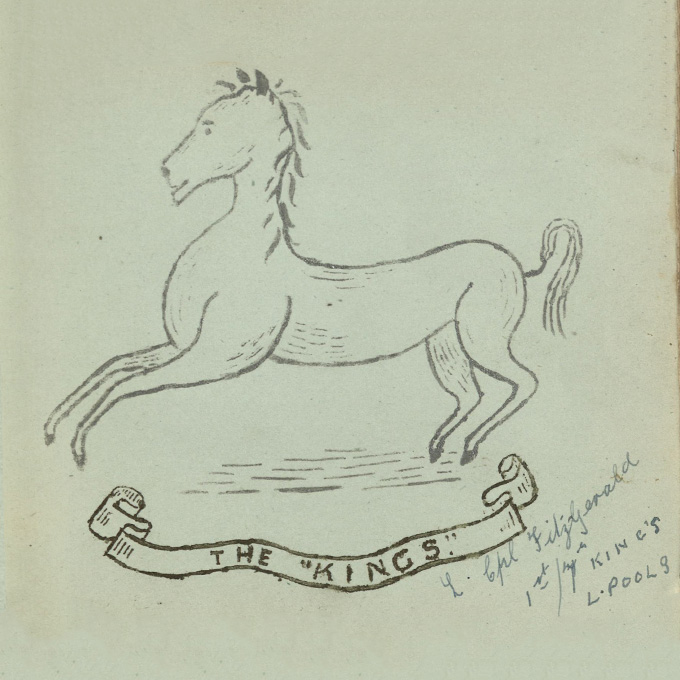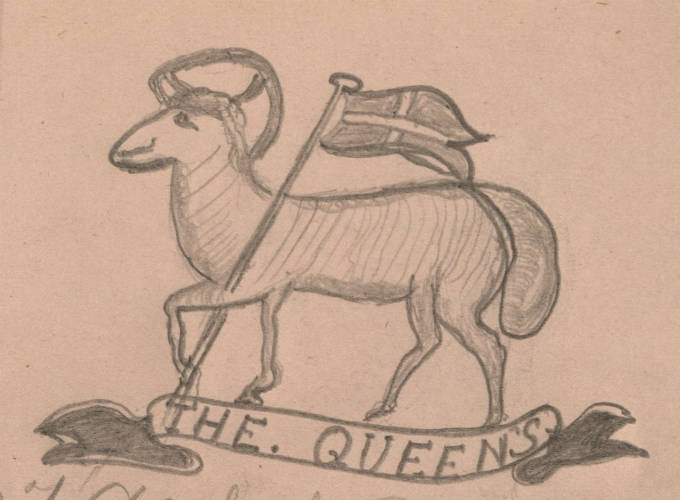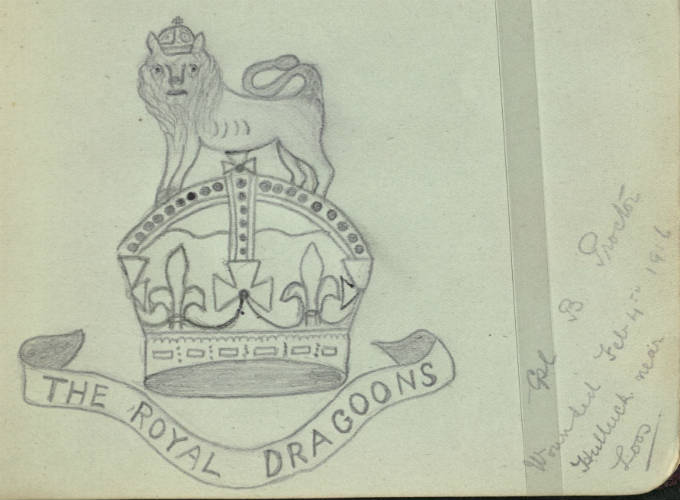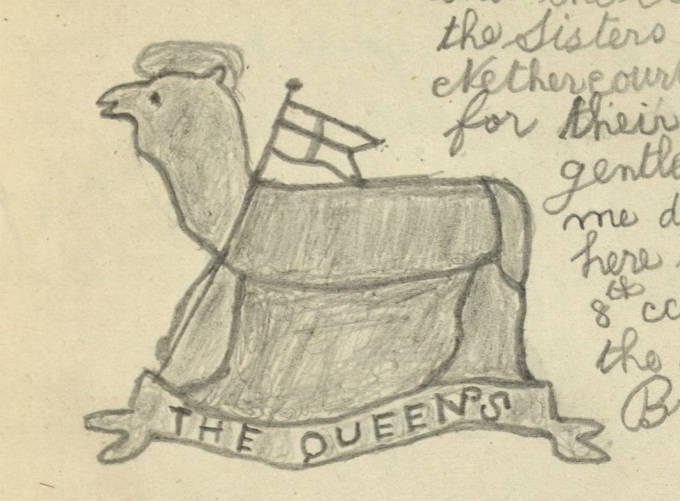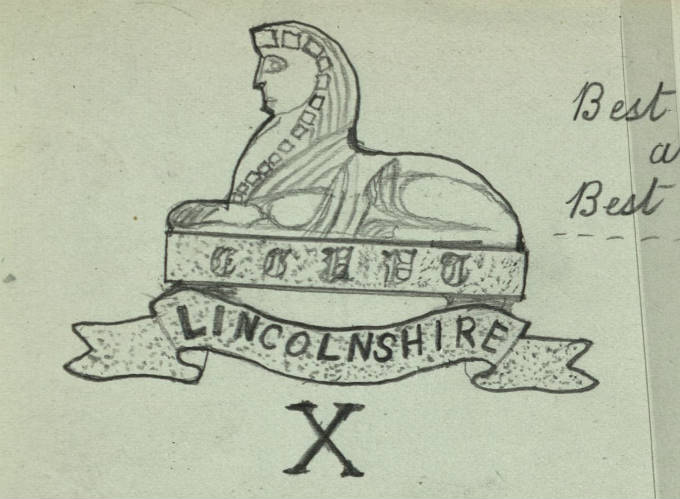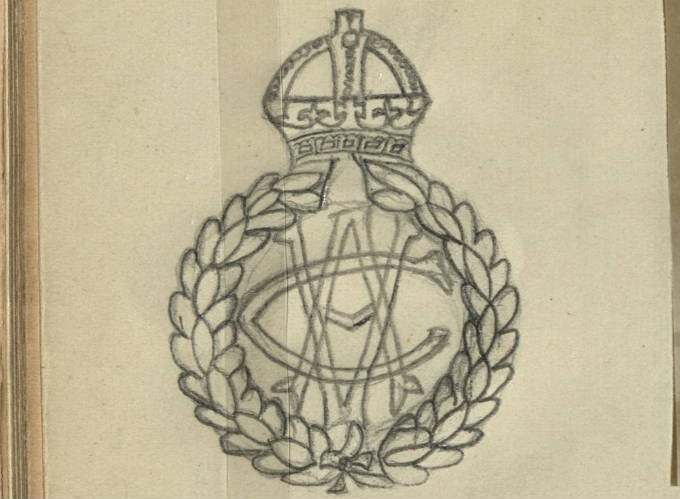May Wilson
“It is true you are a sport. And all the boys will miss you at Nethercourt”
Please note, this scrapbook contains racist and discriminatory language.
If scribbling in albums
True friendships ensures
With the greatest of pleasures
I will scribble in yours
Nursing before the war
May Wilson was born in 1882 in Fulham, London. She began her nurses training at Camberwell Infirmary in 1898, finishing in 1902. The first entry in her scrapbook is a couple of years later and is a 'cure for love' signed only by 'one who knows'. Ingredients included '12 ozs of Dislike, 1 pound of Resolution, 2 ozs of the powder of Experience, A large sprig of Time'. Perhaps this was penned by a friend of Wilson's who thought she needed such a cure. More likely this fantastical concoction was devised by Wilson herself as the handwriting appears to match her signature in the front of the album. Perhaps she was leaving it in her book as a precaution in case she fell in love again.
Her war office record reveals she gained extra qualifications in cookery and massage. The latter would have been incredibly useful in the coming years, as the need for physiotherapy would rocket during the war. Wilson spent a year in the newly-opened South Eastern Fever Hospital in Deptford, London before moving to Canada in 1907. Here she was matron of a maternity hospital. With all this nursing experience Wilson applied to Queen Alexandra's Imperial Military Nursing Service Reserve (QAIMNS(R)) in 1915. She was rejected. This did not deter her and by 1916 she was back in Britain working for the Red Cross nursing the war wounded.
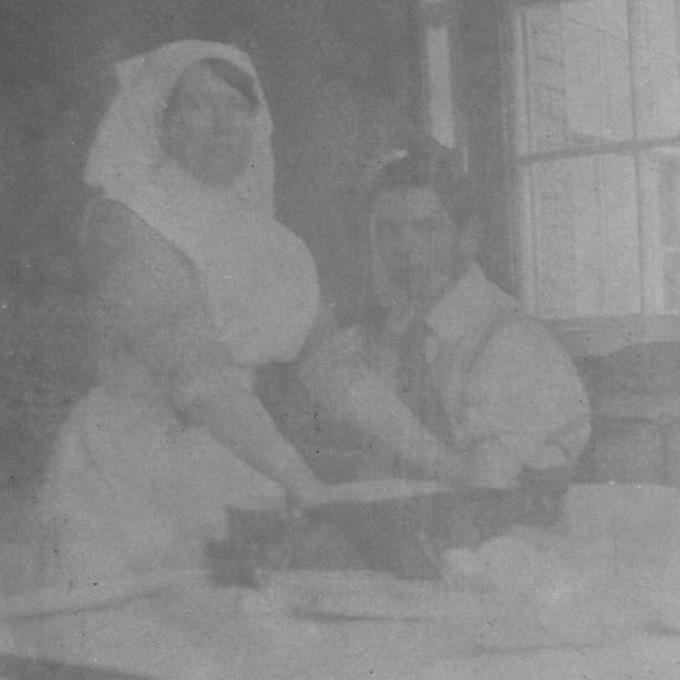
Nethercourt
Indeed the times are out of joint
During 1916 Wilson worked in the Nethercourt VAD Auxiliary Hospital. It is most likely that despite her training she was here in the capacity of a Voluntary Aid Detachment (VAD), an unpaid volunteer. Nethercourt was a small hospital in Ramsgate, Kent. Patients would not have been in a life-threatening condition, but rather needing a place to convalesce. It appears the patients enjoyed their time at Nethercourt as Wilson's scrapbook is filled with compliments to both the hospital and her. Gunner G. Wilson even penned Wilson a small verse in praise of the hospital.
I have found the staff of Nethercourt;
Good hearted & full of sport.
I write these lines.
Because they shine
And for the remembrance of Nethercourt.
Despite such lovely compliments, Wilson continued her applications to be a member of the QAIMNS(R). Finally in March 1917, a year and a half after she first applied, Wilson was accepted. Wilson could now go back to being a paid nurse with a wage and not just the small living allowance she would have received as a VAD. The status was also higher as a member of QAIMNS(R), she was accepted as a professional and would have far more responsibility than as a VAD. Her patients would miss her, one 'R. W.' took the time to write:
It is true you are a sport
And all the boy's will miss
You at Nethercourt.
For she's a jolly good Sister
And so say all of us
Battlefield injury
Many of Wilson's patients sign her scrapbook with a note of how they ended up in hospital, a few of them recording where they were injured. You can see from this map exactly where along the front line this was. One particularly poignant memory is from George Brown, who writes of losing two fellow soldiers in the same spot where he was injured.
On the steepest slopes of Vimy Ridge,
Two comrades off mine lay
I'll go and visit their lovely graves
In just one year and a day.
Private George F. Brown
Wounded May 2 1917 on Vimy Ridge.
Albert. Lance Corporal Harker injured his left wrist here and Lance Corporal G. Gregg was wounded near here on 20 February 1916.
Armentiere. An unnamed soldier was wounded here.
Carnoy. T. A. Stockdale was wounded here.
Hooge. T. Bateman was wounded here on 13 February 1916.
Loos. Captain B. Proctor wounded here on 4 February 1916. Private John Taylor was also wounded here on 12 May 1916.
Sanctuary Wood. Brown was wounded here on 5 February 1916.
Vimy Ridge. G. M. Hecteau was gassed here on 29 April 1917. Private George F Brown was wounded here and two of his friends were killed.
Ypres. Richard Filburn, Corporal F. Jessup and Private T. V. Meara were all wounded here.
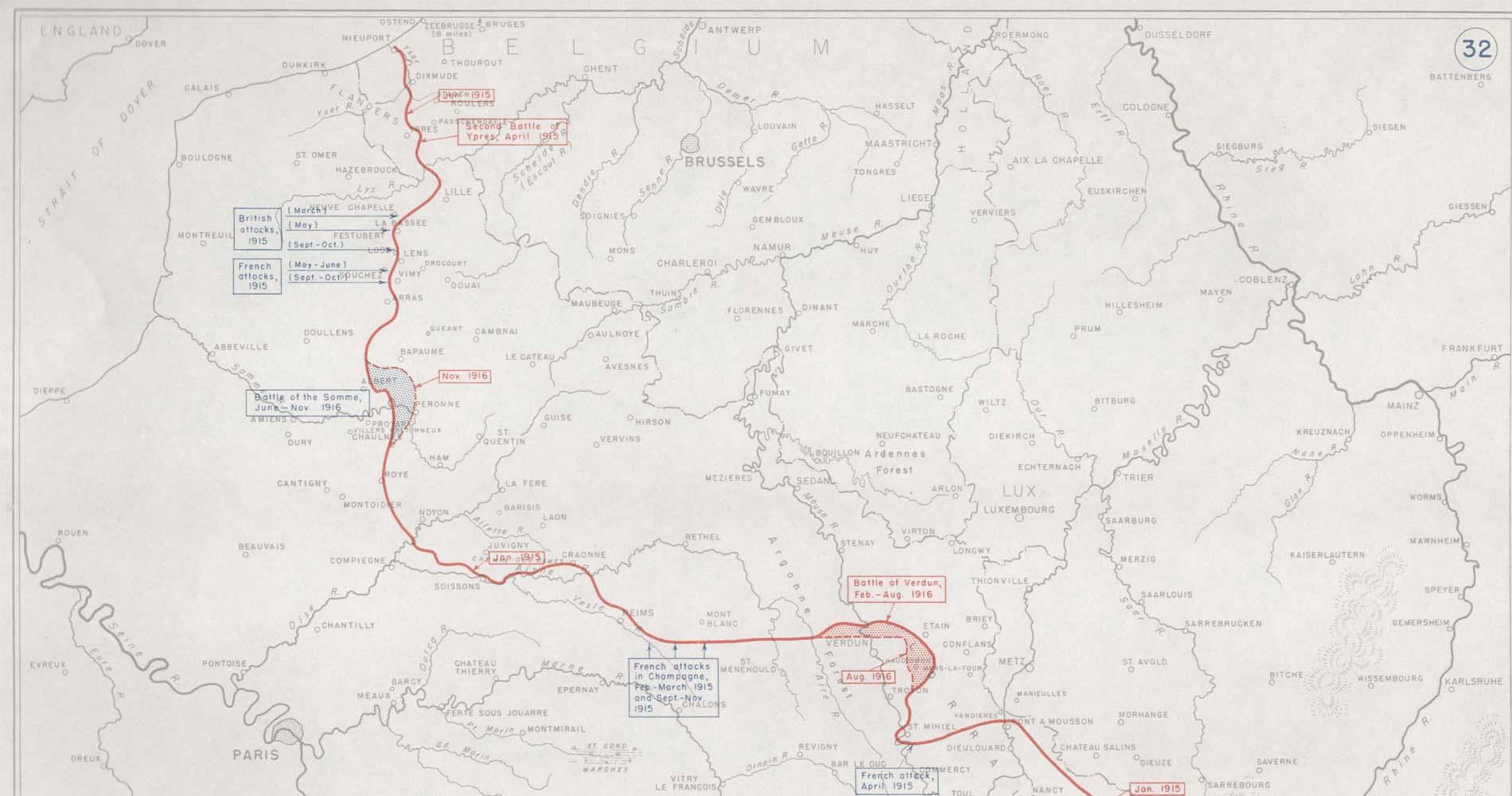
Stoke War Hospital
As a member of QAIMNS(R) Wilson was moved to Stoke War Hospital. Entries from this time in her scrapbook show her to have developed friendships with other nurses. Fellow QAIMNS(R) A. H. Gibson writes a very appropriate poem;
When the words I write here
are dim on the page
And the leaves of this album
Yellow with age
Think of me sometimes
And do not forget
That where ere you may be
I remember you yet
Another signature is from Molly Morgan, who most likely was a nurse too. She quotes 'The Hours I spent with thee dear Heart' implying that her and Wilson had grown close. Wilson was not only popular with her colleagues, her patients at Stoke sign her scrapbook with similar adoration. Private F. T. Goulton writes;
If there are angels earthly
Sister Wilson's one
Badges
Every regiment had their own insignia. This appears to have been a source of great pride for many of the patients in Wilson’s wards, and many of them have taken the time to illustrate their regimental insignia in her scrapbook. This would have been on a detachable army badge that were commonly worn on a cap, collar or cuff. It is likely that many of them kept their badges with them and were drawing from life.
Illness
Almost exactly a year after achieving her aim of joining QAIMNS(R) Wilson became ill. An entry in the scrapbook says she suffered from 'shock'. Most likely this was the same as shell shock, now known as post-traumatic stress disorder, but women were rarely, if ever, diagnosed with the condition. Hence Wilson's war office record skirts around a reason for her hospitalisation. The record shows that her Matron-in-Chief asked for Wilson to be transferred to the Hospital for nurses in Vincent Square, London. She was to await passage home to Canada. After her goodbyes at Stoke, Wilson set off for London, bringing her scrapbook with her.
As it was a hospital for nurses, it is unclear whether the women signing her scrapbook are her nurses or her fellow patients. The entries retain their light tone, but are laced with far more advice and encouragement than before. Helen Burton advises 'be true to the best of yourself […] then you will be happy'. Marian Bateman had similar sentiments, writing of Wilson's strength;
You're a fighter from away back
& you won't take a rebuff;
Your trouble is, you don't know when
You've had enough -
Don't give in
They all appear to be concerned with Wilson's recovery, although none of them specify what her illness is. Their encouraging words do suggest she is suffering psychologically. Wilson was there for just over a month. Her nurse, Margaret Straith, describes her as a 'most "patient" patient' and offers Wilson 'heaps of love'. Sister M. Hill - again unclear whether she is a fellow patient or working nurse - wishes Wilson 'every good wish for a pleasant & safe voyage'. Just as the war was ending, Wilson was heading back to Canada.
Return to Canada
Canada Canada the land of freedom and liberty. Who have send his Sons fourth to uphold the freedom that our father’s fought so dearly for us.
Wilson had been found permanently unfit for further military nursing service and arrangements were made for her to travel as an invalid on the hospital ship 'Neuralia'. She arrived in Canada in June. Her nursing service was considered terminated from her date of arrival. Again she kept her scrapbook with her, and when she was hospitalised in Winnipeg General Hospital those around her signed it. Margaret M. Ross must have had a look through the rest of the scrapbook, and the years of kind words people had written to Wilson. Her own entry is a perfect summary of Wilson's war years:
'That good health may be restored to you soon, as a reward for untiring devotion to your profession and sacrifice to the need of the wounded boys, as is apparent in their expressions of gratitude jotted down in this little book.'
It is uncertain whether Wilson recovered from her shock, so many never did. However, two years after returning to Canada she had sufficiently recovered to marry Henry Beardmore. A newspaper extract describes her wedding dress as a grey charmeuse, paired with a white hat and sable furs. They settled in Winnipeg, and later moved to Vancouver.
Images
Battlefield injury map. Battlefield Maps: Western Front. http://www.firstworldwar.com/maps/westernfront.htm [accessed 22 Feb. 2018]
References
National Archives WO/399/9125. The War Office, 38/W/6052, 2/Reserve W/340. Wilson, Miss M. M.
Groch-Begley. The Forgotten Female Shell-Shock Victims of World War I. The Atlantic [online]. Available at: https://www.theatlantic.com/health/archive/2014/09/world-war-ones-forgotten-female-shell-shock-victims/378995/ [Accessed 27 Feb. 2018]
John, M. (2015). WW1 Great War Centenary - Auxiliary Hospitals: Geograph Britain and Ireland. Available at: http://www.geograph.org.uk/article/Auxiliary-Hospitals/20 [Accessed 10 Apr. 2018].
Light, S., The Reserves – The Fairest Force [online]. Available at: http://www.fairestforce.co.uk/4.html [Accessed 11 Apr. 2018].
Rivett, G. Nhshistory.net. Fever hospitals [online]. Available at: http://nhshistory.net/smallpox_and_fever_hospitals.htm#The%20risks%20from%20the%20hospitals [Accessed 10 Apr. 2018].
Thomas, B., A Brief History of Nursing in the UK [online]. Available at: http://memoriesofnursing.uk/articles/a-brief-history-of-nursing-in-the-uk [Accessed 10 Apr. 2018].
City of Regina Archives Regina: The Early Years 1880 -1950 [online]. Available at: http://scaa.usask.ca/gallery/regina/east/general_hospital.html [Accessed 10 Apr. 2018].
Military Uniform Badges and Portrait Photographs [online] Available at: https://www.iwm.org.uk/history/military-uniform-badges-and-portrait-photographs [Accessed 27 Feb. 2018].
St Giles' Hospital. Lost Hospitals of London [online]. Available at: http://ezitis.myzen.co.uk/stgiles.html [Accessed 10 Apr. 2018].
New Cross Hospital. Lost Hospitals of London [online]. Available at: https://ezitis.myzen.co.uk/newcross.html [Accessed 10 Apr. 2018].
King George Hospital. Lost Hospitals of London [online]. Available at: http://ezitis.myzen.co.uk/kinggeorgestamford.html [Accessed 10 Apr. 2018].
Havil Street Workhouse. Exploringsouthwark.co.uk [online]. Available at: http://www.exploringsouthwark.co.uk/havil-street-workhouse/4592218290 [Accessed 10 Apr. 2018].
The Chartered Society of Physiotherapy. CSP history [online]. Available at: http://www.csp.org.uk/about-csp/history/csp-history [Accessed 10 Apr. 2018].
QARANC. King George Military Hospital Stamford Street London [online]. Available at: http://www.qaranc.co.uk/King-George-Military-Hospital-Stamford-Street-London.php [Accessed 10 Apr. 2018].
London Remembers. King George Hospital, HMSO, Stamford Street [online]. Available at: https://www.londonremembers.com/subjects/king-george-hospital-hmso-stamford-street [Accessed 10 Apr. 2018].
Winnipeg General Hospital / Health Sciences Centre (Bannatyne Avenue, Winnipeg). Manitoba Historical Society [online]. Available at: http://www.mhs.mb.ca/docs/sites/winnipeggeneralhospital.shtml [Accessed 10 Apr. 2018].
